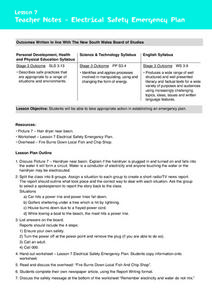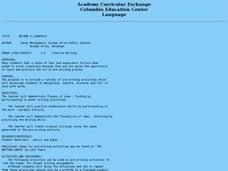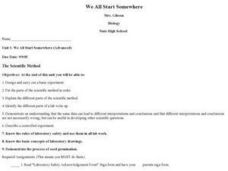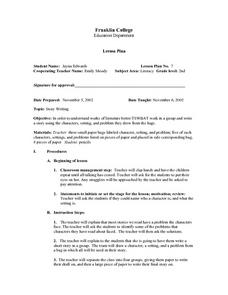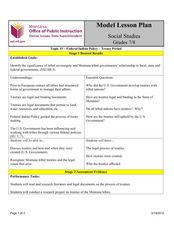Curated OER
Electrical Safety Emergency Plan
Students discuss Picture 7 which is a hairdryer near a basin. They discover that if the hairdryer is plugged in and turned on and falls into the water it will form a circuit and anyone touching the water or hairdryer may be electrocuted....
Curated OER
2 x 2
Students work together to grid a 2 x 2 meter unit using the formula for the Pythagorean Theorem. After creating the grid, they identify the location of artifacts and create a map of their location. They develop a graph and table of their...
Curated OER
The Big Meltdown
Pupils work together to develop a container to keep an ice cube in a solid state. They identify the three stages of matter and test different materials for this experiment. They share their results with the class.
Curated OER
Stories That Grow on Trees
Students write their own choose-a-plot book. They develop skills in creating plot structure and think through a logical line of story action. They invent characters with striking physical and psychological attributes.
Curated OER
Addition & Subtraction Word Problems
In this addition and subtraction word problems instructional activity, students examine, analyze and develop a variety of word problems solving skills involving both addition and subtraction.
Curated OER
The "Coal LIfecycle" Scrapbook
Students discover how coal is formed. In this science lesson plan, students create a scrapbook on the life cycle of coal and show how coal is formed by showing pictures of each stage.
Curated OER
We All Start Somewhere
Students demonstrate an understanding that the same data can lead to different interpretations and conclusions and that different interpretations and conclusions are not necessarily wrong, but can be useful in developing other scientific...
Curated OER
Human Factors
Students design a space settlement for colonizing a planet in our solar system. In small groups, they play a space colony game and read an article about human needs in space to prepare for the design stage. They discuss their design...
Curated OER
Show Me the Number
Second graders develop the ability to show two-digit numbers using place value attributes in the early additive stage five. They utilize the manipulative's of sticks, rubber bands, counters, small canisters and uni-link cubes to assist...
Curated OER
Breaking News English: Eating Fish is Good for the Brain
In this English instructional activity, students read "Eating Fish is Good for the Brain," and then respond to 47 fill in the blank, 7 short answer, 20 matching, and 8 true or false questions about the selection.
Curated OER
Passport to Literacy
Third graders discuss with their partners what they would need to pack for an international trip and share their brainstormed ideas with the class making a web map. They then write paragraph detailing what they should take on the trip...
Curated OER
Creating A Story
Second graders practice the necessary steps that should be taken in order to create a story from scratch. They brainstorm as a class in order to come up with different ideas. Students write a story that includes a plot, characters, and...
Curated OER
Not So Snappy 7
In this math worksheet, students look for the answers to the word problems that focus upon using the number seven. They develop vocabulary and problem solving skills.
Curated OER
Breaking News English: Laboratory-Created Eggs and Sperm
In this English learning exercise, students read "Laboratory-Created Eggs and Sperm," and then respond to 47 fill in the blank, 7 short answer, 20 matching, and 8 true or false questions about the selection.
It's About Time
Conservation of Momentum
Assist your class with understanding collisions as they apply the Law of Conservation of Momentum. Pupils measure the momentum before and after manipulation of two objects so that one strikes another in an inelastic collision. The lesson...
Curated OER
How Do Artists Effectively Relate Historic Events?
Students explore African American migration. In this black culture and history lesson, students use a map to identify northern and southern states in which African Americans lived in the 1900s. Students observe and describe objects and...
Sargent Art
Kandinsky - Inspired by Music
Who is Wassily Kandinsky? Introduce your young artists to the wonders of abstract nonobjective art through music. They'll listen to music as they cut, paste, and paint emotional works of art. The activity suggests the use of soothing...
Thalian Association Community Theatre
West Side Story: Teacher Resource Guide
West Side Story is widely known as a modern-day Romeo & Juliet. Learners read a list of characters from the play and list their counterparts from Romeo & Juliet before completing a vocabulary enrichment activity and word jumble....
Curated OER
Character in a Box
Partners choose, research, and analyze fictional or historical characters and design character life boxes to represent them. They also compose a rhyme royal, which they understand inductively by deconstructing examples. Based largely on...
Curated OER
How Do Cells Reproduce?
Pupils examine cell division and the process of mitosis. In this cell reproduction lesson students grow yeast and observe the results, and learn about the career of scientific illustration.
University of Washington
Pasta Genetics
Four different-shaped and dyed pasta types represent four different alleles. Following a guide sheet, young geneticists practice randomly selecting alleles and discover the traits of the resulting offspring. This is a fun and solid...
Curated OER
What Can I Do?
Students examine their feelings and study constructive ways for resolving conflict. For this feelings and conflict resolution lesson, students learn how to communicate their inner feelings. They complete a worksheet and work on a web...
Curated OER
Federal Indian Policy
Students recognize the provisions of federal Indian policy. In this Federal Indian Policy lesson, students research legal documents (treaties). Students research the Montana tribes. Students answer critical thinking questions based on...


